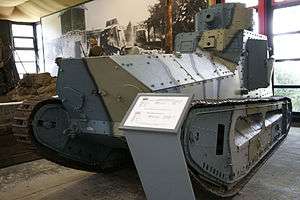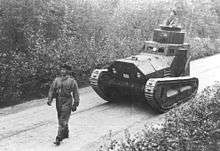LK II
| Leichter Kampfwagen | |
|---|---|
 | |
| Type | Light tank |
| Place of origin | Germany |
| Specifications | |
| Weight | 8.75 t |
| Length | 5.1 m |
| Width | 1.9 m |
| Height | 2.5 m |
| Crew | 3 |
|
| |
| Armor | 8-14 mm |
Main armament | 37mm Krupp/57mm Sokol |
| Engine |
Daimler-Benz 4-cylinder 60 hp |
| Suspension | unsprung |
Operational range | 65-70 km |
| Speed | 14-18 km/h |
The Leichter Kampfwagen II (English: light combat car) or "LK II" was a development of the LK I with the same layout, but incorporating a rotating turret on the rear superstructure armed with a 37mm Krupp or 57mm Maxim-Nordenfelt gun. Its armor was 8 to 14mm thick, which increased its total weight to 8.75 tons. Power was provided by a Daimler-Benz Model 1910 4-cylinder 55-60 hp gasoline engine, giving a maximum speed of 14 to 18 km/h with range of 65–70 km.
A version armed with one or two 7.92mm Maxim 08/15 machine guns was also planned but progressed no farther than a project.
Only two prototypes were produced by June 1918, and were followed by orders for 580 tanks, which were never completed.
Stridsvagn m/21-29
| Stridsvagn m/21-29 | |
|---|---|
 A Swedish m/21 tank. | |
| Type | Light Tank |
| Place of origin | Sweden |
| Service history | |
| In service | 1922-1939 |
| Used by | Sweden |
| Production history | |
| Designer | AB Landsverk |
| Manufacturer | AB Landsverk / NOHAB |
| Number built | 10 |
| Specifications | |
| Weight | 9.7 short tons (8.8 t; 8.7 long tons) |
| Length | 5.7 m (19 ft) |
| Width | 2.05 m (6.7 ft) |
| Height | 2.52 m (8.3 ft) |
| Crew | 4 |
|
| |
| Armor | 4-14 mm |
Main armament | ksp m/14 (2) |
| Engine |
Benz 1910 55 hp |
| Speed | 16 km/h (9.9 mph) to 18 km/h (11 mph) |
Following the war, the Swedish government purchased parts for 10 examples in secrecy for the sum of 200,000 Swedish kronor. The parts were shipped as boiler plates and agricultural equipment and then assembled in Sweden as the Stridsvagn m/21 (Strv m/21 for short), which was essentially an improved version of the LK II prototype. The Strv m/21 was powered by a sleeve valve type engine located in the front, the driver and crew being in the rear. The suspension and running gear was protected by armored skirts. Ten of these tanks were built and were armed with a single 6.5 mm machine gun.[1]
In 1929, five were rebuilt to create the Strv m/21-29 variant which was armed with a 37mm gun or two machine guns and was powered by a Scania-Vabis engine. The Strv m/21-29 was an upgraded version of the fm/21. The modifications included a more powerful engine, a new alternator, and external lighting.[2] One of these improved vehicles was driven by Heinz Guderian during a visit to Sweden in 1929.
The Germans later bought a main share of the Landsverk Company and made Otto Merker the main designer and in 1931, it produced the Strv m/31 (L-10), which was the first tank produced in Sweden.
The Strv m/21-29 remained in service until 1938. A surviving example can be seen at the Deutsches Panzermuseum at Munster, Germany, and both strv m/21 and strv m/21-29 was displayed at the Axvall Tank Museum in Sweden.
One Strv m/21-29 is in the early stages of being restored to full working order in Sweden.[3]
| Wikimedia Commons has media related to Leichter Kampfwagen II. |
References
- ↑ Chamberlain, Peter (2002). Tanks of the World, 1915-1945. United Kingdom: Cassell & Company. p. 159. ISBN 9780304361410.
- ↑ "Stridsvagn m/21-29". Pansarmuséet i Axvall. Retrieved June 13, 2016.
- ↑ http://blog.arsenalen.se/